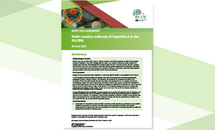Rapid Risk Assessment: Multi-country outbreak of hepatitis A in the EU/EEA
This rapid risk assessment provides an overview of a multi-country hepatitis A outbreak in the EU/EEA during early 2025, highlighting its impact on vulnerable populations and identifying two closely related virus strains across affected regions.
Epidemiological situation
Between January and May 2025, Austria, Czechia, Hungary, and Slovakia reported a higher-than-expected number of hepatitis A virus (HAV) subgenotype IB cases. Two clusters involving two closely related HAV subgenotype IB strains were identified from sequence data from four countries (Austria, Germany, Hungary and Slovakia). This rise in HAV infections is primarily affecting adults experiencing homelessness, individuals who use or inject drugs, and those living in poor sanitary conditions. Additionally, cases have been reported among members of the Roma communities in both Czechia and Slovakia.
Risk assessment
People who have not previously been infected by, or vaccinated against hepatitis A are susceptible to HAV infection. In the European Union/European Economic Area (EU/EEA) countries currently experiencing outbreaks (Austria, Czechia, Hungary, and Slovakia), the probability for sustained transmission and circulation of the virus within groups who are more likely to be exposed to HAV (i.e. people experiencing homelessness, people who use or inject drugs, and people living in poor sanitary conditions) is assessed as high. Within these groups, the risk of the disease is assessed as moderate for those below 40 years of age and high for adults 40 years of age or older, as the severity of the disease increases with age. For people with predisposing liver disease or older adults, the risk can be very high. The risk for the broader population in these countries is assessed as low to moderate.
In non-affected EU/EEA countries, as there currently are no reports of increases in HAV IB infections, and therefore considering the very low probability of infection, the risk for the broader population is assessed as very low to low. However, it is important to note that the probability of infection is higher among groups more likely to be exposed to HAV, and the impact of disease increases with age and predisposing conditions, thus the overall risk may vary across different population groups.
Recommendations
- Investigate HAV transmission routes in EU/EEA countries currently experiencing outbreaks (to spot possible foodborne transmission or spill-overs into other groups at increased risk of infection) and increase sequencing both in groups more likely to be exposed to HAV and within the broader population to reflect the epidemiological diversity of reported cases.
- Targeted single dose pre-exposure hepatitis A vaccination programmes for populations who are not vaccinated and who are more likely to be exposed to the virus.
- Provide post-exposure prophylaxis to close contacts of cases by administering the hepatitis A vaccine, or in very specific circumstances hepatitis A immunoglobulins, in accordance with national guidelines to prevent secondary cases.
- Consider targeted vaccination of population groups more likely to be exposed to HAV in low and very low endemicity settings to provide individual health benefits.
- Tailor outreach to populations more likely to be exposed to HAV based on an understanding of their needs, attitudes and knowledge, to inform strategies to embed vaccination programmes and hygiene interventions into services that are easily accessible to them. Provide information in multiple languages, adapted to different literacy levels, and address rumours and misinformation that may be circulating.
Download





